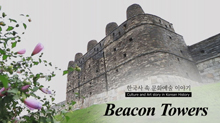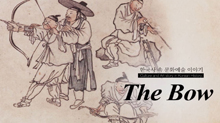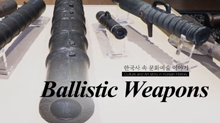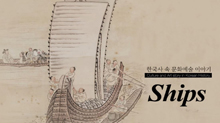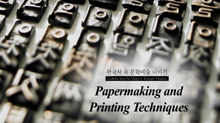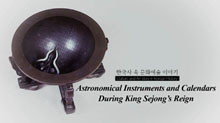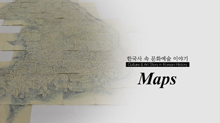The Story of Culture and Arts
- Image resource of Korean history
- Documents from History TextBooks
- Culture & Art Stories from Korean History
- Culture & Art Stories from Korean History - Korean
- National Institute of Korean History
- History net
- About the site
- Introduce
-
Numerous topics related to Korean culture and art are mentioned in middle and high school national history textbooks, but most of them are briefly described by era, making it difficult to understand their concepts, transition processes, and characteristics.
<Culture & Art Stories from Korean History> produces and provides video materials based on expert commentary on the flow, change process, characteristics and characteristics of each major topic in the field of culture and art in Korean history.

Scenario
Hanji, Korean traditional paper that has not changed even after a thousand years.
It is made by the hands of master craftsmen, sheet by sheet, only through traditional methods, making it paper of superior quality.
“The bark of the mulberry tree weakens when submerged in water. But once removed, it becomes stronger than cloth or steel.” Ahn Chiyoung, Hanji jang (Korean Paper-Making) / Chungcheongbuk-do, Holder of Intangible Cultural Heritage Property
Our ancestors felt scholarship was very important, so much so that they fostered a paper and printing culture in order to record life for others to read. Let's take a look at this extraordinary feat.
The Invention that Changed Mankind - Papermaking
Mankind has recorded characters or letters on various types of material. But only with the invention of paper are we able to say that printing technology truly flourished.
The paper of Korea, Hanji.
Hanji, made from the bark of the mulberry tree, is boiled in ash lye and then laid out until completely dry.
It takes almost a hundred hands to collect all the mulberry bark and make a single piece of paper, giving it its other name, “Baekji”(one-hundred paper).
Due to the way it is made, Hanji is both durable and resistant to tearing.
Even after a thousand years, the color of the paper is unaltered, making it optimal for preservation.
This book, slightly over 1200-year-old, contains the Buddhist Sutras from the Unified Shilla period, and best demonstrates the paper’s characteristics.
Hanji is also very soft and smooth. This allows ink to glide smoothly across its surface without clumping.
The ‘Dongtian qinglu’(洞天淸錄)(Pure Records of the Cave Heaven), by Zhao Xihu of the Song Dynasty, says that Goryeo paper was made by cocoons, and was as glossy white and durable as silk. It also absorbs ink very well. Thus it may be said that all who know it love it. As this type of paper does not exist in China, it is quite a rare item Seongho Saseol (Miscellaneous Discussions of Seongho) by Yi Ik
Hanji was also a very popular type of paper in China. Paper from Goryeo (or Korea) was highly praised for its likeness to silk in both durability and its white sheen. Hanji was widely regarded as a type of luxury paper, which it is still considered even today.
Woodblock Printing Receives Love Over Time
The invention of printing technology followed soon upon that of paper manufacture. This gave rise to a culture of recording information and the collective knowledge of mankind.
In woodblock printing, characters are carved onto a piece of wood, which is then wetted with ink and stamped on to a piece of paper.
Advantages to this method are the possibility of reprinting of the same material multiple times and the possibility of printing elaborately detailed pictures or maps.
The world’s oldest extant example of a woodblock-printed work is the Mugujeonggwang daedaranigyeong. It stands as an exemplar of Korea's advanced printing technology.
The printing woodblocks of the “Tripitaka Koreana” stored at Haeinsa Temple, Hapcheon, and dating from the Goryeo Dynasty, deserve to be called the crystallization of various woodblock printings.
The “Tripitaka Koreana” is also called by many the “Palman Daejanggyeong”(Eighty-Thousand Tripitaka) as this sacred compendium of Buddhist scriptures is carved into over 80,000 woodblocks.
The first edition of the “Tripitaka Koreana,” which was created around 1011 to fend off an invasion by the Khitans, was destroyed in a fire during the subsequent Mongolian invasion, and this led to its reproduction.
In remaking the “Tripitaka Koreana,” the aim was to establish the central government’s authority while controlling public sentiment. It was also done to prevent another invasion by the Mongolian army through the power of Buddhism.
But the “Palman Daejanggyeong” was not simply a restoration of the first edition of the “Tripitaka Koreana”.
It contained the most Buddhist scriptures of its time by reflecting all the Tripitakas made in East Asia.
The book was also cross-checked with other collections to ensure there were no errors, making it the most perfect and complete collection of Buddhist scriptures to ever exist.
Over 52 million carved characters make up the “Palman Daejanggyeong”. A typeface was set for the book to make it look as if it were written by a single person. The workmanship involved in making the text is extraordinary. There is barely a mistake or omission in the entire text.
It is a cultural heritage piece of the highest level of perfection.
UNESCO recognized the “Palman Daejanggyeong” for its contribution to both history and civilization, and awarded it the status of a UNESCO Memory of the World.
Joseon, the Golden Age of Movable Metal Type
After woodblock printing came movable typesetting. Made of either wood or metal, type pieces were arranged individually into a specific order, according to the text. The arranged letters were then stamped on to a sheet of paper. Once a type piece was made, it could be rearranged and used over and over again when needed to print books. This made them an easier and superior alternative to woodblocks.
Movable type printing technology, originally invented in China, developed into movable metal type technology in the Goryeo Dynasty.
In 1377, the second volume of Anthology of the Zen Teachings of the Great Buddhist Priests was published. The Buddhist text still exists today and is the oldest book made by movable metal type in the world.
The Joseon Dynasty took Goryeo's movable type technology that they had inherited and began to produce it vigorously.
We now know that over 30 sets of moveable metal type were made, with the number of individual type pieces numbering into the millions.
Wooden moveable type were made by regular citizens as well, and its production was much more common than metal type.
King Taejong of Joseon created Gyemija (癸未字) type, Joseon’s first metal typeface, making it clear that books were critical to sound governance.
The king ordered his subjects to make tributes of copper and poured all the royal finances into making Gyemija type.
King Sejong's efforts paid off when in 1434 he created the typeface Gabinja.
Gabinja was composed of 200,000 characters. The shape of the characters was uniform, as opposed to earlier typefaces which had irregular shapes, making printing much faster.
Due to its ease and elegance, Gabinja became the principal font used during the Joseon Dynasty.
In 1795, King Jeongjo and his mother paid their respects at the grave of his late father, Crown Prince Sado. The event was recorded in a book printed with the metal type, Jeongnija.
Prior to this, in accordance with royal protocol, the event would have been handwritten and then made into books. But now, events were recorded and printed using the metal type so that more people would be able to read them.
The Annals of the Joseon Dynasty were of course printed using movable metal type. Special metal typefaces were made just for printing the Annals of King Hyeonjong.
During the Joseon Dynasty, Hangeul was not the official writing system. But, to facilitate governance, movable types of Hangeul characters were also manufactured to print Buddhist Scriptures and Confucian texts translated into Hangeul.
There are no Gutenberg types left in existence today. But, the fact that movable types of Hangeul survive to this day deserves worldwide admiration.
Thanks to Korea's early recognition of the importance of books, as well as its efforts to advance printing and paper-making techniques throughout history, Korea's culture of documenting and storing information was able to flourish.
[Epilogue]
Must-Know Facts on Culture and Art in Korean History
1. Traditional paper called Hanji uses mullbery bark as its main ingredient.
2. The PalmanDaejanggyeong was made to ward off Mongol invasions and unify the people.
3. During the reign of King Taejong, Joseon created its first metal typeface called Gyemija.


